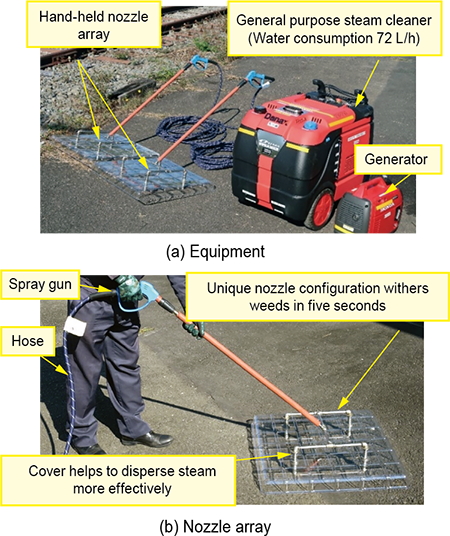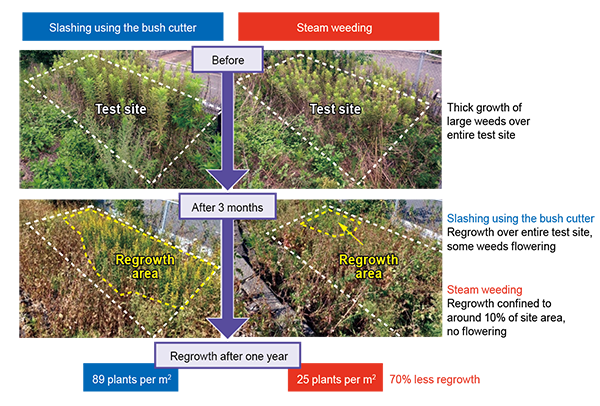21. Effective and efficient steam weeding technique
Slashing using the bush cutter is generally considered a faster way to remove weeds growing on railway field between the tracks and the side boundaries. During summer, however, weeds can grow back quickly, while workers can only use bush cutters for relatively short periods due to the health impacts of vibration. In addition, signaling and communication cables near to tracks have to be protected from potential damage by the bush cutter. Steam spraying is an effective and efficient weeding technique that is used in the agricultural sector. The heat of the steam causes thermal denaturation of key proteins in weeds and effectively withers them . We have adapted this process for weed control on railway field.
Conventional steam weeding requires considerable quantities of water as well as a dedicated large boiler designed for mains water. Our technique uses a general purpose steam cleaner fitted with a high-efficiency hand-held nozzle array specifically developed for use on railway field, where access to water may be limited. Compared to conventional steam weeding, the nozzle array uses less than one-tenth as much water (72 l/h vs. 1,000 l/h), while still providing sufficient heat to wither weeds and also be easier to use (see Figure 1). In addition no requirement need to protect signaling and communication cables since steam weeding does not involve a slashing blade.
Trials conducted at a test site covered in thick growth of large weeds found that weed regrowth three months after steam weeding was no more than around 10%, while the number of plants reappearing after one year fell by 70% (see Figure 2).
Steam weeding was also found to be 44% faster per unit area. It would take an estimated 50 minutes to cover an area of 300 m2 including preparation to finish, some 30% faster than slashing using the bush cutter, which takes 72 minutes. Steam weeding also delivers a 60% labor saving, since it requires only three workers rather than five.
Other Contents
- 9. Integrated analytics platform for railways
- 10. On-board obstacle detection system suitable for low-light conditions
- 11. Tool for estimating bridge deflection from on-board track irregularity measurements
- 12. Wear measuring apparatus for overhead conductor rail using light sectioning
- 13. Imaging analysis method for detecting various anomalies in overhead contact lines
- 14. Automated crew scheduling system
- 15. Fast-track embankment structure for confined settings
- 16. Numerical analysis method for predicting interaction impacts on closely adjacent tunnels
- 17. Method for evaluating girder vibration characteristics with consideration for track rigidity
- 18. Concrete repair methodology based on crack width and location
- 19. Using expansive concrete in track slabs to minimize reinforcement
- 20. Using temperature sensors to help predict service life of electronic signallingequipment
- 21. Effective and efficient steam weeding technique
- 9. Integrated analytics platform for railways
- 10. On-board obstacle detection system suitable for low-light conditions
- 11. Tool for estimating bridge deflection from on-board track irregularity measurements
- 12. Wear measuring apparatus for overhead conductor rail using light sectioning
- 13. Imaging analysis method for detecting various anomalies in overhead contact lines
- 14. Automated crew scheduling system
- 15. Fast-track embankment structure for confined settings
- 16. Numerical analysis method for predicting interaction impacts on closely adjacent tunnels
- 17. Method for evaluating girder vibration characteristics with consideration for track rigidity
- 18. Concrete repair methodology based on crack width and location
- 19. Using expansive concrete in track slabs to minimize reinforcement
- 20. Using temperature sensors to help predict service life of electronic signallingequipment
- 21. Effective and efficient steam weeding technique


